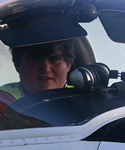 by Eddy Current » Tue Jun 19, 2007 12:41 pm
by Eddy Current » Tue Jun 19, 2007 12:41 pm
A common misconception is that the P-38 had counter-rotating props to eliminate the hazards that appear when a "critical engine" fails. That is not the case. With the P-38, the propellers both rotate outward at the top, which makes BOTH engines "critical engines". From what I've read, the only reason Kelly Johnson settled on the final setup was that it made a more stable weapons platform, which is the only reason the plane existed.
A "critical engine" failure is only a problem when the wing is at a high angle of attack (aircraft going slow with the nose up), and the engines are at high RPM/power. The propeller blade angles are equal relative to each other, but not to the relative wind. The descending blade is at a higher relative pitch and takes a bigger "bite" out of the air than the ascending blade, so at a high angle of attack, the thrust of each propeller is asymmetrical.
When viewed from the pilot's seat, the standard for rotation in the U.S. is clockwise. On a plane with identical engines, the descending blade on the left engine is inboard, and the descending blade on the right engine is outboard. If the right engine fails, the tendency to yaw and roll is lessened because the centerline of the thrust provided by the left engine at full power is closer to the centerline of the aircraft. If however the left ("Critical") engine fails, the centerline of thrust from the right engine at full power is outboard of the engine, and the yawing moment is much larger. An unwary pilot may not be able to recover from the resulting roll to the left in time if it happens close to the ground, like during take-off.
If the engines counter-rotate inward at the top, neither engine is critical. If they counter-rotate outward at the top ~which the P-38's did~ BOTH engines are critical. Adding the engine's tremendous torque to the equation made things even worse. Many young, inexperienced crews were lost in that manner.
That this made things more dangerous for the crews was of concern, but there was a different mentality during the war. Hagar mentioned having an engine failure on take-off. In the Pacific, bomb and fuel loads were calculated without regard to the possibility of an engine failure on take-off. If you lost an engine before you rotated, you ran off the end of the runway and crashed. If you lost an engine shortly after take-off, you better drop your ordinance, because with still full fuel tanks, less than full power on all engines could not keep you aloft. It was understood that crews would be lost, but there was a job to do, and they took the risk in order to put as much steel on target as possible and finish the war.
Eddy Current
Pilot and Airframe & Powerplant Mechanic















 )
)

)

